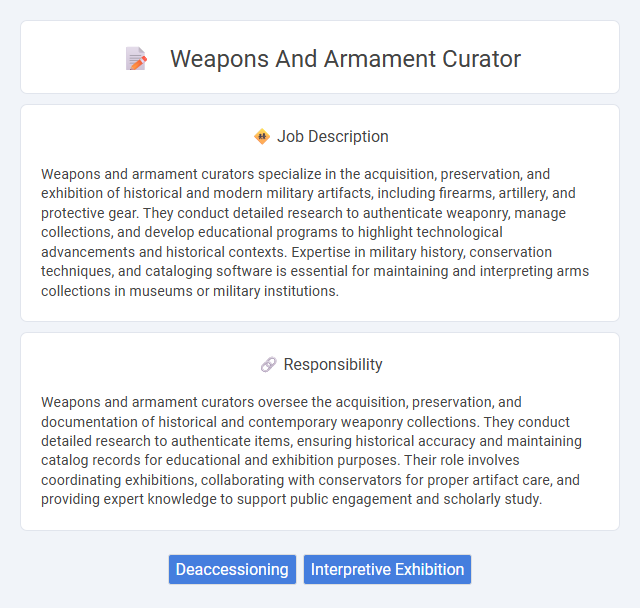
Weapons and armament curators specialize in the acquisition, preservation, and exhibition of historical and modern military artifacts, including firearms, artillery, and protective gear. They conduct detailed research to authenticate weaponry, manage collections, and develop educational programs to highlight technological advancements and historical contexts. Expertise in military history, conservation techniques, and cataloging software is essential for maintaining and interpreting arms collections in museums or military institutions.
Individuals with a strong attention to detail and a passion for history and weaponry are likely suited for a weapons and armament curator role, given the need to carefully preserve and catalog artifacts. People who prefer hands-on, methodical work and have patience in maintaining delicate items might find this job fitting. Those less comfortable with meticulous record-keeping or handling historical arms cautiously may struggle in this position.
Qualification
A Weapons and Armament Curator typically holds a bachelor's or master's degree in history, military studies, museum studies, or a related field, with extensive knowledge of historical and modern weaponry. Proven expertise in artifact preservation, cataloging, and security protocols is essential, alongside skills in research, documentation, and exhibition design. Professional experience in museums, military collections, or archives, combined with strong analytical and communication abilities, enhances effectiveness in managing and interpreting arms and armament collections.
Responsibility
Weapons and armament curators oversee the acquisition, preservation, and documentation of historical and contemporary weaponry collections. They conduct detailed research to authenticate items, ensuring historical accuracy and maintaining catalog records for educational and exhibition purposes. Their role involves coordinating exhibitions, collaborating with conservators for proper artifact care, and providing expert knowledge to support public engagement and scholarly study.
Benefit
A Weapons and Armament Curator likely gains specialized knowledge and expertise in historical and modern weaponry, which can enhance career advancement opportunities in museums or defense institutions. There appears to be a strong probability that the job offers access to rare artifacts and unique collections, enriching professional experience. Exposure to preservation techniques and historical research may further contribute to long-term skill development and job satisfaction.
Challenge
A Weapons and Armament Curator likely faces the challenge of preserving delicate historical artifacts while ensuring their accurate representation and interpretation for educational purposes. The role probably demands balancing conservation techniques with evolving technological advancements in weaponry documentation. Managing safety protocols and navigating legal restrictions on weapon displays could also present ongoing complexities in the position.
Career Advancement
A Weapons and Armament Curator advances by developing deep expertise in historical and modern weaponry, leading exhibitions, and authoring scholarly research that enhances museum collections. Progression often involves managing larger teams, securing funding for acquisitions, and collaborating with defense institutions for access to rare artifacts. Mastery of conservation techniques and digital cataloging also positions curators for leadership roles within major museums or academic institutions.
Key Terms
Deaccessioning
Weapons and armament curators oversee the careful deaccessioning process to ensure the responsible removal of obsolete or redundant items from a museum's collection. This process involves detailed documentation, legal compliance, and collaboration with regulatory agencies to manage the ethical disposal or transfer of weapons and armaments. Expertise in historical weaponry, safety protocols, and provenance research is essential to maintain collection integrity during deaccessioning.
Interpretive Exhibition
A Weapons and Armament Curator specializing in interpretive exhibition designs engaging narratives around historical and technological contexts of military artifacts. They meticulously research and authenticate weaponry collections, ensuring accurate representation of their cultural and functional significance. Mastery in exhibit curation, educational program development, and preservation techniques fosters immersive visitor experiences in museums and heritage institutions.
 kuljobs.com
kuljobs.com